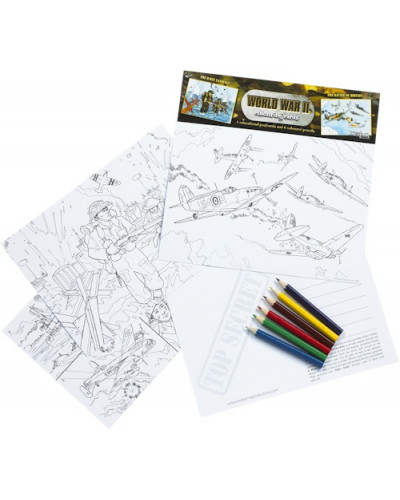World War II Educational Colouring Postcards
- Product Code: WW2CC
- Availability: In Stock
- Pack Qty: 10
Product Description: The World War II Colouring Postcards consists of four A5 size colouring cards and six colouring pencils. The cards include an image of a Battle of Britain scene, a D-Day scene, a card depicting four images of the Home Front and a card depicting four images consisting of a Royal Navy ship, British army soldiers, a Bomber Command Lancaster and Winston Churchill. On the reverse of each card is an area to write a message, an address and to affix a stamp as well as educational information about the images on each card. There is a colourful header card that has pictures showing how the cards could be coloured in and all are held in a clear cellophane bag.
Information: The Battle of Britain (10 July 1940 – 31 October 1940) was the name given to the aerial conflict between the British and German air forces in the skies over the United Kingdom in the summer and autumn of 1940. The British Royal Air Force defeated the German Air Forces’ (Luftwaffe) attempt to gain air supremacy over southern England and saved Britain from German invasions.
On the 6th of June 1944 (D-Day) 2,700 ships carrying landing craft and over 130,000 soldiers crossed the English Channel. At 6:30am allied troops stormed ashore onto the beaches of Normandy, France, in the largest sea-borne invasion in history. The beaches were given code names – Utah, Omaha, Gold, Juno and Sword. By 30th June 1944 the Allies had established a firm foothold in Normandy which led finally to the German army surrendering on May 8th 1945.
The term 'home front' is the name given to the activities of the civilians during World War II. ARP wardens or air-raid wardens had the task of patrolling the streets during air raids and dousing incendiary bombs. Children were evacuated from the towns and moved to the countryside. Women took over the jobs of men in the factories. Home Guard units had to protect Britain from German parachute attacks. They kept a look out for spies and guarded factories and airfields. Their nickname was "Days Army" because some of them were quite old.
The Merchant Navy would travel in convoys escorted by the Royal Navy who protected them from submarine attacks and mines. The British Army fought campaigns all over the world from the jungles of Burma to the deserts of Africa. Bomber Command was given the job of attacking strategic targets like railways and factories. Winston Churchill was the Prime Minister of the UK. He helped morale by visiting the troops and bombed out areas throughout the country.
Tags: World War II, Educational, Colouring, Postcards

